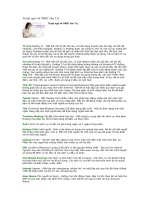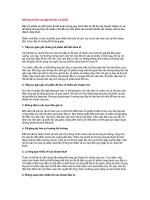POINT & FIGURE CHARTS REVISITED pptx
Bạn đang xem bản rút gọn của tài liệu. Xem và tải ngay bản đầy đủ của tài liệu tại đây (3.03 MB, 3 trang )
28 AAII Journal/November 2000
TECHNICAL ANALYSIS
constructed using this data, which is
a continuation of the chart in Figure
1.
When creating a point and figure
chart, it is helpful to determine the
“action points” for each day. If a
chart is in a column of O’s, as was
the case at the end of May (the last
column in Figure 1), the first action
point is the price that is one box
lower than the last. If the price falls
to this point, we add another O to
the existing column. The second
action point would be the price at
which a three-box reversal occurs.
This point is three boxes above the
last O. If this point is reached, we
would then switch to a new column
of X’s.
When you are in a column of X’s,
the first action point is at the price
one box above the last X. The point
where a three-box reversal takes
place is where the price is three
boxes below the last X. When this
level is reached, we switch to a new
column of O’s.
In Figure 1, the last box closed in
May at 57. Since we are in a
column of O’s, the first action point
is 56, one box below 57. The other
action point is 60, which is three
boxes above our last box of 57.
Now, let’s walk through the
plotting of the next several days of
data using Figure 2.
June 1: Since we ended May in a
column of O’s, we must first see if
the price fell. Look at the low price
for the day: 57.875. When plotting
point and figure, it is easier to deal
in whole numbers, so the high and
low prices for a given day are
rounded upward or downward
depending on whether you are in a
column of X’s or O’s. When you are
in a column of O’s, you round the
low price up to the next whole
number, in this case 58. Since 58 is
By Wayne A. Thorp
Wayne A. Thorp is assistant financial analyst of AAII.
POINT & FIGURE CHARTS REVISITED
In the August 2000 issue of the
AAII Journal, we introduced the
seemingly forgotten art of point and
figure charting. These charts illus-
trate the underlying supply and
demand for a security while ignoring
the passage of time. You can find
this article at the AAII Web site
(www.aaii.com) using the search
tool. Member feedback prompts us
to offer this supplement to the
article, correcting a few mistakes
and more explicitly laying out how
the sample point and figure chart
was plotted.
CORRECTION
The time period for Figure 1 in the
August article is mislabeled. The
chart for Cisco is stated as covering
the period January 4, 1999, through
April 31, 1999. This chart, repro-
duced here in Figure 1, actually
covers the time period January 4,
1999, through May 31, 2000.
The high/low price table in Figure
2 in the August article shows
italicized dates corresponding to
those dates where a shift in column
takes place from X’s to O’s or O’s
to X’s. June 5 is incorrectly italicized
when, instead, June 6 was the date
to shift from a column of X’s to a
column of O’s. The explanation
below walks you through this shift.
One final note on the August article:
Figure 6 shows a double-top forma-
tion at $37, which we failed to label.
POINT & FIGURE STEP-BY-STEP
To walk through the construction
of a point and figure chart, look at
Figure 2 here. The table on the left
shows high and low prices for Cisco
for the period May 31, 2000,
through June 27, 2000. On the right
side is the point and figure chart
above our first action point of 56,
we do not add another O to our
column. We then look at the high
price for the day to see if a three-
box reversal has taken place. The
high of 61.125 must also be
rounded, but when dealing with high
prices we round down to the next
whole number. Comparing 61 to the
second action point of 60, we see
that a three-box reversal has oc-
curred since the high price is above
the second action point. We there-
fore shift to a new column of X’s
that begins at 58, one box above the
lowest O, and goes up to 61.
June 2: Begin by determining the
action points. Since on the prior day
we recorded X’s up to 61, our first
action point—where we would add
another X—is 62. The other action
point, for a three-box reversal, is at
58 (61 – 3). The high for the day is
65.750, which we round down to
65. Since this is higher than the first
action point, we stay in the column
of X’s and record them up to 65.
June 5: The action points are 66
(one box above the last X at 65) and
62 (three boxes below 65). The high
for the day is 65, so we do not plot
another X. The low for the day is 63
(62.438 rounded up), not enough for
us to move to a new column of O’s.
Therefore we make no marks for the
day.
June 6: Since we did not record
anything the prior day, the action
points remain at 66 and 62. The
high for the day of 63 is below the
first action point, so we do not
record any additional X’s. The low
for the day of 62 matches the second
action point. Therefore, a three-box
reversal has taken place and we shift
to a column of O’s that begins one
box below the highest X in the
previous column and continues
down to 62.
June 7: The action points for today
are 61 and 65. Looking first at the
low of 62, we do not add another O
AAII Journal/November 2000 29
TECHNICAL ANALYSIS
to the column because it is not low
enough to record an O at 61. The
high for the day of 63 is not high
enough for a three-box reversal.
Therefore, nothing is recorded for
the day.
June 8: The action points remain
the same—61 and 65. The low for
the day is 63, so we do not record
any O’s. The high for the day is 65,
which is high enough to result in a
three-box reversal. We therefore
move to a new column of X’s that
begins at 63 (one box above the
lowest O of the previous column)
and goes up to 65.
June 9: The action points for the
day are 66 and 62. Looking at the
high first (since we are now in a
column of X’s), we see that it is not
high enough to record an X at 66.
The low for the day—64—is not at
or below the point needed for a
three-box reversal, so we make no
mark for the day.
June 12: The action points are still
66 and 62. The high of 65 is not
high enough for a new X, and the
low of 63 is not low enough for a
three-box reversal. For the second
straight day we record nothing.
June 13: Again the action points
are 66 and 62. The high of 65 is not
high enough for a
new X, but the low
of 62 is low enough
for a three-box
reversal. Our new
column of O’s
begins at 64 (one
box below the
highest X of the
previous column)
and goes down to
62.
June 14: The new
action points are
61 (62 – 1) and 65
(62 + 3). The low
for the day of 65 is
not low enough to
add another O. The
high for the day—
66—is enough for a
three-box reversal,
so we shift to a
new column of X’s
that begins at 63
and goes up to 66.
June 15: The
action points are 67 and 63. The
high for the day of 66 is not high
enough for another X and the low of
65 is not low enough for a three-box
reversal. Nothing is recorded for the
FirstFirst
FirstFirst
First
SecondSecond
SecondSecond
Second
PricePrice
PricePrice
Price
ActionAction
ActionAction
Action
ActionAction
ActionAction
Action
DateDate
DateDate
Date
HighHigh
HighHigh
High
LowLow
LowLow
Low
PointPoint
PointPoint
Point
PointPoint
PointPoint
Point
5/31/00 60.250 56.375
6/1/006/1/00
6/1/006/1/00
6/1/00
61.12561.125
61.12561.125
61.125
57.87557.875
57.87557.875
57.875
56 60
6/2/00 65.750 63.438 62 58
6/5/00 65.063 62.438 66 62
6/6/006/6/00
6/6/006/6/00
6/6/00
63.81363.813
63.81363.813
63.813
61.12561.125
61.12561.125
61.125
66 62
6/7/00 63.500 61.125 61 65
6/8/006/8/00
6/8/006/8/00
6/8/00
65.00065.000
65.00065.000
65.000
62.75062.750
62.75062.750
62.750
61 65
6/9/00 65.000 64.000 66 62
6/12/00 64.750 62.125 66 62
6/13/006/13/00
6/13/006/13/00
6/13/00
65.00065.000
65.00065.000
65.000
61.50061.500
61.50061.500
61.500
66 62
6/14/006/14/00
6/14/006/14/00
6/14/00
66.50066.500
66.50066.500
66.500
64.12564.125
64.12564.125
64.125
61 65
6/15/00 66.625 64.625 67 63
6/16/00 67.938 65.797 67 63
6/19/00 69.250 66.250 68 64
6/20/00 69.563 66.625 70 66
6/21/006/21/00
6/21/006/21/00
6/21/00
67.75067.750
67.75067.750
67.750
65.75065.750
65.75065.750
65.750
70 66
6/22/00 67.125 64.438 65 69
6/23/00 65.938 62.500 64 68
6/26/00 63.625 61.063 62 66
6/27/006/27/00
6/27/006/27/00
6/27/00
65.25065.250
65.25065.250
65.250
62.12562.125
62.12562.125
62.125
61 65
FIGURE 1. POINT AND FIGURE CHART FOR CISCO SYSTEMS (1/4/99 TO 5/31/00)
FIGURE 2. CREATING A POINT AND FIGURE CHART
30 AAII Journal/November 2000
TECHNICAL ANALYSIS
day.
June 16: The action points are
again 67 and 63. The high is 67,
which means we add another X to
our column at 67.
June 19: The action points are
now 68 and 64. The high of 69
means that we again add X’s to the
column at 68 and 69.
June 20: The action points are 70
and 66. The high of 69 is not
enough to add another X. The low
of 67 is not low enough for a three-
box reversal. Nothing is recorded
for the day.
June 21: The action points remain
at 70 and 66. The high for the day
is 67, which is not enough to add
another X to the column. The low of
66, however, is enough for a three-
box reversal, so we shift to a new
column of O’s that begins at 68 (one
box below the highest X from the
previous column) and goes down to
66.
June 22: Our action points for the
day are 65 and 69. The low for the
day of 65 is below our first action
point, so we add another O at 65.
June 23: The action points for the
day are 64 and 68. The low for the
day is 63, meaning we add another
two O’s to the column at 64 and 63.
June 26: The action points for the
day are 62 and 66. The low for the
day—62—matches our first action
point, so we record an O at 62.
June 27: The action points for the
day are 61 and 65. The low for the
day is 63, which means we do not
record any O’s for the day. The high
is 65, which matches the second
action point. Therefore, we shift to a
new column of X’s that begins at 63
and goes up to 65.
If you wish to learn more, you
may check out the Dorsey Wright
Web site—one of the few point and
figure sites around
(www.dorseywright.com). ✦
TABLE 6. BREAKEVEN AGES FOR DELAYED RETIREMENT BENEFITS:
FIVE-YEAR WITHDRAWALS
Net Return on Investments
5% 6% 7% 8% 9% 9.29%
Accumulated Fund $67,813 $69,454 $71,131 $72,847 $74,600 $75,110
Years to Breakeven 10.5 11.4 12.6 14.1 16.1 16.9
Breakeven Age From Age 70 80.5 81.5 82.6 84.1 86.1 86.9
Survival Probability From Age 70 63% 57% 52% 45% 37% 32%
SOCIAL SECURITY BENEFITS AT AGE 65:
DELAY, OR TAKE THE MONEY AND RUN?
The number of years to
breakeven in Table 6 in the article
on Social Security benefits was
incorrect. The article, which
appeared in the August 2000
issue, discussed whether individu-
als were better off taking Social
Security benefits starting at age
65 or delaying them to age 70 to
receive higher payments via the
delayed retirement credit. In the
table, the number of years to
breakeven should have been
added to age 70, rather than to
age 65 as it appeared in the
article. The corrected table is
printed
below.
In the table, breakeven occurs
when the total payments from the
higher delayed benefits are equal to
the total payments that would have
been received if Social Security was
taken earlier. The assumption in
Table 6 is that if benefits begin at
age 65, one-third of the monthly
benefit will go to income taxes, and
the remainder will be invested each
month for a term of five years.
Thereafter, an amount will be
withdrawn from the accumulated
fund each month such that, com-
bined with the regular benefit, the
total will equal the monthly benefit
that would be received had one
delayed benefits to age 70. It
assumes annual inflation adjust-
ments of 2.4%. Under this
scenario, Table 6 shows that the
breakeven age is essentially the
same as the breakeven age when
the benefit is taken at age 65 and
spent (scenario one in the
article). The risk of delaying the
benefit is the same as the risk all
workers faced under prior law by
not retiring before age 70. Given
that risk, and the probability of
reaching the breakeven age, one
could argue that delaying the
benefit could be a viable option.
AUGUST ARTICLE CORRECTION









